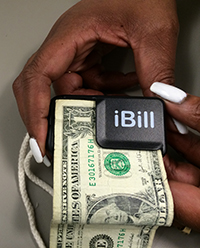At a conference recently, I received a free money identifier. What is this? How did it happen?
The saga is long and complicated. And, your real questions might be:
- How do I get in on this?
- But wait, what happened to the accessible money?
If you are reading this from another civilized country, you might be puzzled. Accessible money? What is inaccessible about money?
In the United States, the bills are all the same size and have no (OK, don't quibble, no practical) tactually discernable features. Meaning, if I receive $16 in change for my twenty-dollar bill, I must come up with some strategy for knowing what is what. (See AFB's site VisionAware.org for some strategies for identifying money.)
The US Bureau of Engraving and Printing was tasked with solving the money-marking problem and began testing workable and unworkable approaches. They've been at all the conferences for several years, showing samples, taking surveys, doing tests with real money users and real money. It's been a fascinating process to watch.
But, still no money. And, when the currency begins to roll out, it will take a long, long time for it to get done. Imagine how long an undifferentiated $20 bill is going to be in circulation after the new ones hit the streets! We'll be using our current flawed techniques for a long time to come.
So, (I'm skipping some grueling and conflictive/conflicted steps that got us to this point) the US Bureau of Engraving and Printing selected a money identifier and is distributing them to all people with visual impairments in the US. Whew, what a job!
This summer, they were at the big conferences—the American Council of the Blind, the National Federation of the Blind, and the Association for the Education and Rehabilitation of the Blind and Visually Impaired, at least—giving out the devices. In January, the big project will begin; they will distribute the devices through the National Library Services for the Blind and Physically Handicapped cooperating library system, so recipients of Talking Books and related services will be eligible to receive money identifiers.
If you want to get in on this, what do you do?
First, make sure you are signed up and are current with your local NLS cooperating library. If you've moved, get that all straightened out. Not an NLS patron? Oh, seriously, you are missing out. This will be a blog post for another day, but, if you have a print disability, go get signed up! See a general NLS profile and a list of libraries on the AFB site to get started.
Next, watch the sites of the US Bureau of Engraving and Printing and the National Library Service to see what you should do next.
Let's look at the device. The one being distributed is the iBill® Talking Banknote Identifier, from Orbit Research.
AccessWorld® offered a thorough review and description of the iBill's features about a year and a half ago. But essentially, you put a bill, short end first, into a slot in the device, push a button, and it announces the denomination of the bill. It has options for tones or vibration patterns to clue you, if you can't hear. And, it has a headphone jack if you prefer the voice and don't want to insult a cab driver.
If you're using a money identifier, let us know what you think by commenting on this blog post!
